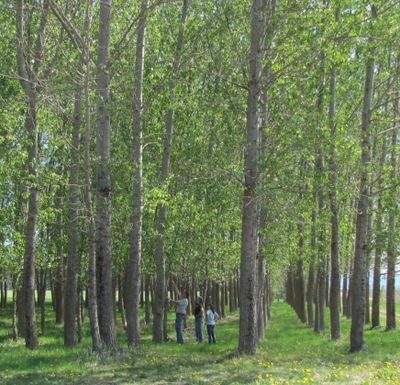Tree project aims to protect aquifer

A five-year project to use trees to promote the health of the Spokane-Rathdrum Prairie Aquifer has wrapped up, with new trees planted, a blueprint for where to plant more, a boost for a Hayden program that uses poplar trees to drink up treated wastewater, and various efforts to promote forest health throughout the region.
“Knowing how trees could benefit the aquifer, we had a really unique opportunity,” said Mary Fritz, program planning specialist for the Idaho Department of Lands in Coeur d’Alene.
The department secured a $300,000 federal grant, which was matched with local funds from an array of agencies including the Idaho department and the Washington Department of Natural Resources; cities, utilities, private landowners, the Washington State University Extension, Spokane County Conservation District and more.
A centerpiece of the project was an analysis of the tree canopy in Kootenai County, where urban areas were found lacking – trees cover just 14 percent of Coeur d’Alene, 7 percent of Hayden, and 6 percent of Rathdrum and Post Falls, though the cities want to increase that to 30 percent.
Spokane, by contrast, is nearly 22 percent covered with trees.
Now, cities in Kootenai County have a database showing where more trees are needed, for everything from shade and energy savings to filtering out water and air pollutants and reducing runoff and erosion.
The project also included tree-planting and wildfire hazard reduction projects. Educational programs reached out to private forest land owners in both states; others targeted teachers and schoolchildren.
In Post Falls, 61 acres of city-owned forest land within the critical recharge area for the aquifer was thinned and treated for insect infestations; interpretive signs were installed in Q’emiln Park to educate the public about the value of forest health, including to the aquifer.
“It certainly has heightened awareness,” Fritz said.
Hayden saw one of the most dramatic impacts; there, the regional sewer district uses a plantation of poplar trees to slurp up its treated wastewater during the summer months. But an infestation of sawflies was ravaging the trees. “They would defoliate all our trees shortly after the leaves got to be full-sized,” said Hayden Area Regional Sewer Board Director Ken Windram.
The Department of Lands helped the district identify and eradicate the pest, and plan for ongoing control efforts. “We haven’t had an issue with the sawflies since then,” Windram said.
The sewer district uses the fast-growing poplar trees plus about 250 acres of alfalfa to drink up its wastewater in the summer months, when the Spokane River drops below 1,000 cubic feet per second at the Post Falls Dam and it’s no longer safe to discharge the treated water into the river. Because the aquifer – the sole source of drinking water for half a million people in the region – lies below the plantation, the trees’ water consumption must be constantly monitored to make sure they consume all the water.
“We do that by monitoring the soil moisture,” Windram said. “We think the poplars do a very good job.”
The tree project is just a small piece of the region’s ongoing efforts to protect the aquifer. Dick Martindale, manager of environmental health for the Panhandle Health District, said extensive efforts to prevent contaminants from getting into the aquifer, through everything from sewage regulations to monitoring chemical storage and stormwater runoff, have paid off.
“After 30-plus years, we can say yeah, these programs actually work,” Martindale said. “The water quality was poor back in the ‘70s and has actually improved through the ‘80s and early ‘90s, and now it’s stabilized, even with the massive increase in growth and development that we’ve had. So the good news is that we’re very successful – you can still in Idaho put in a well and pump out safe, clean drinking water without having to treat it, which is kind of remarkable.”